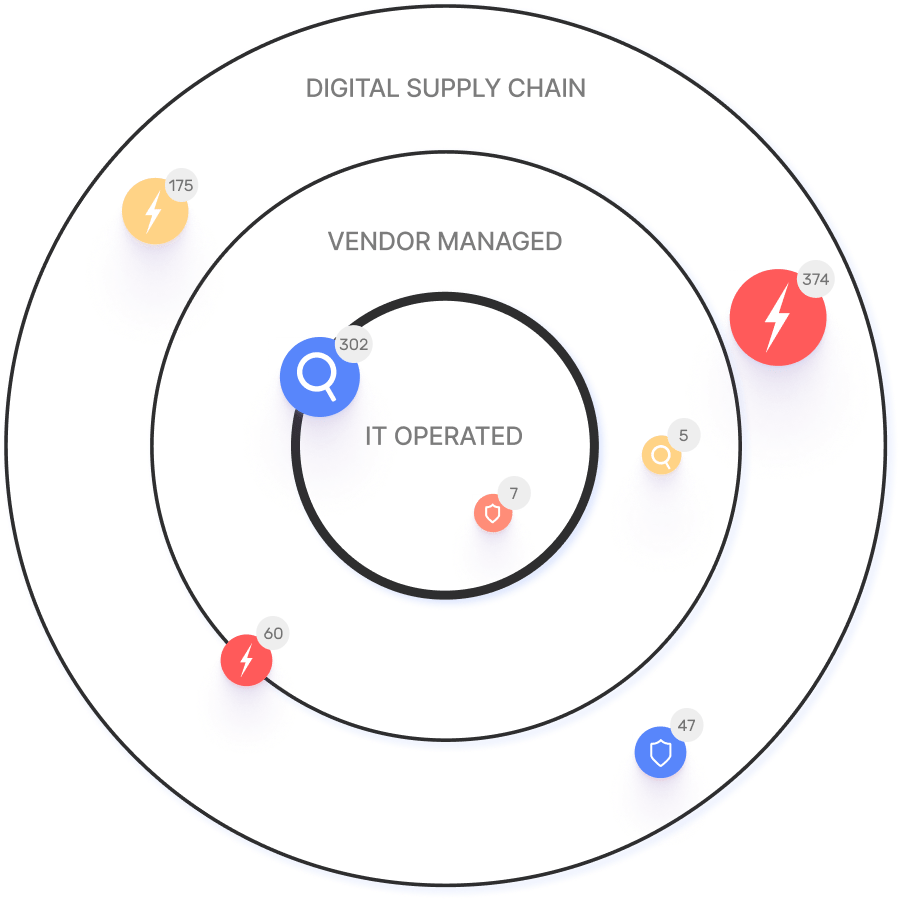Why Attack Surface Assessment Tools Are Vital According to Gartner

Attack Surface Assessment tools enable information security teams to look at their organizations “outside-in” from the attacker’s point of view, prioritizing the issues that attackers will see first.
In this article
What is Attack Surface Assessment?
Attack Surface Assessment is the thorough investigation and analysis of all the digital points in an organization where a security breach could occur. It’s a deep dive into your network’s nooks, examining every internet-facing asset, whether websites, APIs, cloud services, or remote devices. The process identifies and catalogs these points, assessing their vulnerabilities. By laying out the entire landscape of potential risks, ASA empowers organizations to safeguard against breaches proactively. It’s about knowing where you stand in the digital domain and shoring up defenses where they’re needed most.
The Dire Need for Attack Surface Assessment Tools
According to Gartner, traditional cybersecurity technologies are missing much of the big and expanding picture. They suffer from a lack of visibility into the exposed attack surface, which is growing in leaps and bounds due to accelerated digital transformation and cloud adoption. Many security teams rely on manual processes to manage far-flung assets, assess their vulnerabilities, and evaluate their associated risk exposure to compensate. This is an impossible task.
The modern attack surface is increasingly external, embracing numerous internet-facing assets and supply chains. Rapidly scaling SaaS applications, use of the cloud, and work from home are major factors contributing to this growth and increased exposure. Already 3x greater than the traditional attack surface, the expanding external attack surface is far too broad to see, manage, and protect with the standard cybersecurity tool chest.
Security teams need help, and new tools are coming to the rescue. With the aid of the latest ASA tools, reflecting Gartner’s attack surface assessment insights, the number of companies with more than 95% visibility over all their digital assets is forecasted to grow 20x over the next four years.
Attack Surface Assessment Tools to Drive 20X Growth and 95% Visibility (Gartner)
ASA tools are a new and vital weapon in the cybersecurity arsenal. They help organizations understand their vast attack surface from the cyber attacker’s point of view. They deliver a comprehensive view across the entire asset inventory, broadening the context of what assets are “in scope” of the company’s attack surface. They also prioritize issues based on attack risk, organizing digital assets around practical security use cases and boosting the efficiency and effectiveness of cybersecurity operations.
Types of Attack Surface Assessment Technologies
Modern attack surface assessment tools can be categorized into three areas of technological innovation.
Cyber Asset Attack Surface Management (CAASM) focuses on helping security teams solve persistent asset visibility and vulnerability challenges through API integrations with existing tools. With CAASM, cyber pros can query against consolidated data, identify the scope of vulnerabilities and gaps in security controls, and remediate issues. CAASM tools are not the source of records but aggregate data from other sources.
Digital Risk Protection Services (DRPS) offer a combination of technology and services that protect critical digital assets by providing visibility into social media, the dark web, and deep-web sources. They can provide contextual information on threat actors, including tactics and malicious activities for threat-intelligence analysis.
External Attack Surface Management (EASM) uses processes and technologies to automatically discover an organization’s internet-facing assets and any associated vulnerabilities that could be exploited in 3rd party software, servers, credentials, cloud services, etc. External Attack Surface Management is part of attack surface management and has practical use cases for organizations today, especially when it does not require intrusion into the network or integration with other tools or processes.
Why External Attack Surface Management is Essential for Today’s Cybersecurity
Efforts to assess the attack surface, especially the external component, present several challenges, primarily due to the dynamic and complex nature of modern digital environments:
- The SolarWinds attack was executed by hackers who added malicious code into a widely used software package. They then watched it get distributed via normal software updates, enabling the breach of tens of thousands of customers, including Fortune 500 companies and multiple agencies of the US government like the Pentagon, the Department of Homeland Security, and the Treasury. The hack remained under the radar for months before rearing its ugly head.
- Starting in 2015 and still very much a problem today, Magecart attacks exploit 3rd party and supply chain vulnerabilities to attack sophisticated and well-protected organizations. Specializing in theft of personal information, Magecart attacks often go undetected for months and even years.
- Cloud infrastructure vulnerabilities in Amazon Web Services (AWS) storage services resulted in multiple major enterprise data leaks at booking.com, Capital One, and Expedia, among many others.
Challenges in assessing your attack surface
Efforts to assess the attack surface, especially the external component, present several challenges, primarily due to the dynamic and complex nature of modern digital environments:
- Rapid Expansion of Digital Infrastructures: A primary challenge in practicing Gartner’s attack surface assessment is the increase in connected devices, systems, and cloud instances, which leads to an ever-expanding range of potential vulnerabilities. This rapid growth outpaces the capacity of security teams to document, manage security assets, and monitor network activity effectively, leading to potential threats on unmanaged or unknown technology assets.
- Complexity of Environments: The blend of on-premise, cloud, and remote work models adds difficulty in the digital attack surface assessment. Organizations often struggle to define their attack surface comprehensively, frequently omitting SaaS applications and public cloud resources despite their connectivity to critical IT environments.
- Maintaining Accurate Asset Inventory: Aligning ASM programs with cybersecurity, IT, and DevOps activities is critical, as emphasized in Gartner’s attack surface assessment. However, under pressure to integrate new platforms and deploy software updates, development teams can inadvertently contribute to the complexity of the attack surface.
- Legacy and Ineffective ASM Solutions: Reliance on outdated or manual ASM solutions hinders effective attack surface assessment. Many organizations still use spreadsheets for inventory or rely on manual patching, and legacy ASM platforms may not adapt well to current needs, particularly in managing external assets and compliance requirements.
Why External Attack Surface Assessment is Essential for Today’s Cybersecurity
Recent major breaches show how risk exposure has climbed due to the growing use of external-facing infrastructures like cloud resources and 3rd party supply chains. For example:
- The SolarWinds attack was executed by hackers who added malicious code to a widely used software package. They then watched it get distributed via normal software updates, enabling the breach of tens of thousands of customers, including Fortune 500 companies and multiple agencies of the US government like the Pentagon, the Department of Homeland Security, and the Treasury. The hack remained under the radar for months before rearing its ugly head.
- Starting in 2015 and still a problem today, Magecart attacks exploit 3rd party and supply chain vulnerabilities to attack sophisticated and well-protected organizations. Specializing in the theft of personal information, Magecart attacks often go undetected for months and even years.
- Cloud infrastructure vulnerabilities in Amazon Web Services (AWS) storage services resulted in multiple major enterprise data leaks at booking.com, Capital One, and Expedia, among many others.
Strategic Threat Prevention
In contrast to many reactive cybersecurity tools, External Attack Surface Assessment is about proactive identification. Advanced assessment tools scan the external attack surface to discover all internet-facing assets, and then analyze their vulnerabilities and provide risk-based prioritization. This proactive assessment empowers cybersecurity teams to reduce the attack surface by identifying and addressing critical risks before hackers can exploit them.
Cybersecurity Automation
With the external attack surface expanding rapidly, organizations need automated solutions for thorough and ongoing assessment of all assets, including domains, sub-domains, owned IPs, Shadow IT, and Managed Services. This automation extends into the digital supply chain, providing comprehensive visibility into an organization’s risk posture.
Enhancing Assessment with IONIX External Attack Surface Assessment
Listed as a vendor in Gartner Competitive Landscape for Attack Surface Management report, IONIX furthers external protection. Our solution exhaustively assesses an organization’s internet-facing assets, and digital supply chains. Adapting dynamically to an organization’s online footprint, IONIX enables cybersecurity teams to assess their expanding attack surface at the pace of digital business. Experience IONIX in action: beyond a mere demo, our solution executes a comprehensive and non-intrusive scan of the external attack surface, delivering detailed asset inventory and vulnerability insights.






